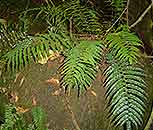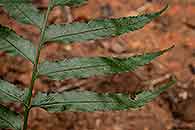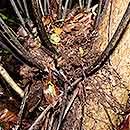Asplenium anisophyllum Kunze
Synonyms |
Asplenium geppii Carruth. |
|---|---|
Common name |
|
Description |
Rhizome erect, to 2 cm in diameter; rhizome scales pale brown, lanceolate in outline, 6-12 x 1.5-3.5 mm, apex pointed, margin divided into a fringe of slender lobes. Fronds tufted, pinnate, not proliferous. Stipe up to 48 cm long, matt brown, hairless with few scales at base similar to rhizome. Lamina 20-88 × 8-32 cm, ovate-elliptic in outline, 7-20 pairs of pinnae, terminal pinna at the apex of the frond resembling the middle pinnae. Pinnae 5-16 x 1.5-3 cm, narrowly lanceolate in outline, apex pointed or tapering to a point, asymmetric at the base, glabrous above with a few scales on costae and veins below, margins toothed with a vein ending in each crenation. Sori linear, 2.5-6 mm long, set along the veins at (45°?) 60° to the costa, extending from near the costa to halfway to the margin; indusium to 1.2 mm wide, membranous, entire, opening towards the costa. |
Notes | Differs from similar species by not proliferous fronds that have many pinnae, toothed margins and a dull green colour. |
Derivation | Aniso-: unequal; -phyllum: leaf (pinnae): the pinnae basis of this species is assymmetric. |
Habitat | Shaded areas in moist, evergreen forest. |
Distribution worldwide | Africa, Madagascar. |
Distribution in Africa |
Angola, Burundi, Dem. Republic of Congo, Equatorial Guinea (incl. Bioko), Ethiopia, Kenya, Liberia, Malawi, Mozambique, Nigeria, South Africa, Sudan and South Sudan, Swaziland, Tanzania , Uganda, Zimbabwe. |
Growth form |
Epiphytic, lithophytic, terrestrial. |
Literature |
|





